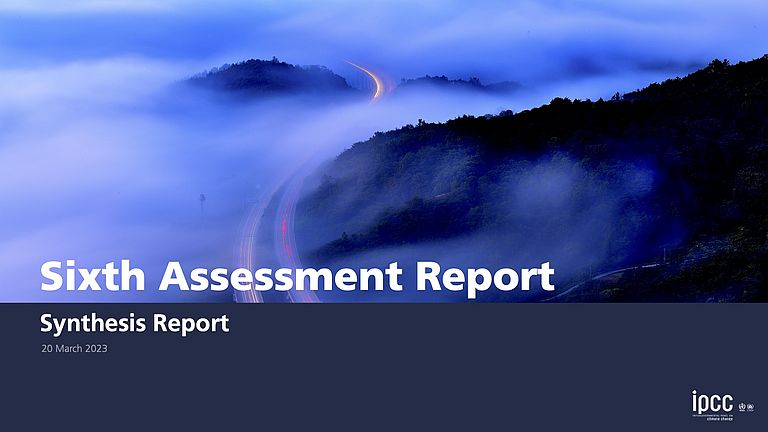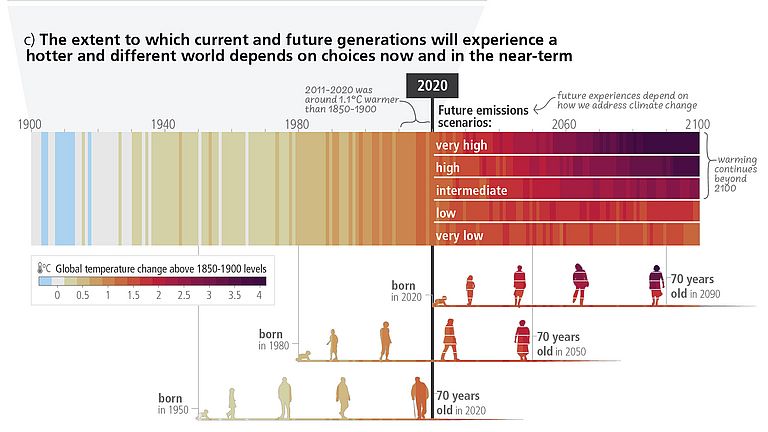Research for a climate resilient and equitable future for all
Researchers from GEOMAR comment on the new IPCC Synthesis Report
The international community has got options to fight climate change and to adapt to impacts that cannot be avoided anymore to safeguard human well-being and planetary health for future generations around the world: With its Synthesis Report that integrates knowledge from the current Sixth Assessment Cycle, the Intergovernmental Panel on Climate Change (IPCC) sends a clear and positive message. It is effectively the IPCC’s last one while limiting global warming to 1.5° Celsius as decided by governments in the Paris Agreement would still be feasible.
Researchers at GEOMAR Helmholtz Centre for Ocean Research Kiel comment on the report:
GEOMAR Director Professor Dr. Katja Matthes:
Average global warming has already reached 1.1° Celsius. Consequences of climate change such as loss of biodiversity and extreme weather events including heat, drought, heavy precipitation, storms and floods are already affecting people and their livelihoods around the world. Those who have contributed least to climate change are most affected. Given these facts, it is clear that global efforts are needed to combat climate change. Produced in cooperation between science and policy and being approved in consensus by government representatives, the new IPCC report provides us with an excellent basis for this.
GEOMAR helps to answer important questions for implementation – from knowledge about changes in the role of the ocean in the climate system, biodiversity and biogeochemical cycles to options that could make the ocean an ally in our fight against climate change. International cooperation, also involving stakeholders outside the natural sciences, is an important driver here, complemented by our commitment to a climate-equitable future for all within the framework of the United Nations Decade of Ocean Research for Sustainable Development.
Professor Dr. Mojib Latif, Meteorologist:
Even in scenarios that assume very low emissions, we are very likely to reach a global average warming of 1.5° in the near future – but with strong regional variation. What is more, we see large emission gaps between scenarios that would limit warming to 1.5° or 2° Celsius, countries’ pledges communicated in the framework of the “National Determined Contributions” (NDCs) and their policies implemented so far.
We have no choice but to do better. Because every fraction of a degree of warming affects our climate system, increases heat waves, droughts and heavy precipitation, seasonal shifts of weather patterns, sea level rise and many other impacts of climate change. There is only one way to stop this acceleration: We need to cut our emissions immediately and drastically.
Professor Dr. Thorsten Reusch, Marine Biologist
From tropical coral reefs to polar regions, ocean biodiversity is lost at unprecedented rates, while individual species often reach limits of their capacity to adapt to climate change. Among other aspects, this also affects our food security, because yields from fisheries and aquaculture also decline as a consequence of climate change.
But conserving, protecting and restoring biodiversity to maintain our natural life support system is still possible. For example, best practise examples and effective management measures show that depleted fish stocks can be quickly rebuilt. Active habitat restoration – for the Baltic Sea we can think of our seagrass and algal meadows – can enhance carbon uptake with additional benefits for biodiversity. Also, water- and vector borne diseases are on the rise and need our attention – an aspect that marine researchers from Kiel are increasingly focusing on.
Professor Dr. Andreas Oschlies, Earth System Modeller
The IPCC scenarios indicate that nature-based solutions have many co-benefits, for example for biodiversity, ecosystem functioning and local livelihoods – but these solutions are not sufficient at all to limit global warming to 1.5° or 2° Celsius. Therefore, in addition to drastic reductions in carbon dioxide and other greenhouse gas emissions and a fast transition to renewable energy sources, we also depend on technical options to remove and safely store carbon dioxide from the atmosphere. The longer it takes to substantially reduce our emissions, the more challenging it will be to establish such techniques at sufficient scale.
Research as conducted in the mission „Marine Carbon Sinks in Decarbonisation Pathways” (CDRmare) of the German Marine Research Alliance (DAM) evaluates options for carbon dioxide removal to inform societal decisions and support the development of appropriate governance schemes.
Professor Dr. Matin Visbeck, Physical Oceanographer:
Large changes lie ahead of us when it comes to transitioning to a more sustainable world – and major questions still remain unanswered. GEOMAR research addresses key aspects from fundamental climate processes to solutions options. We also look for novel approaches for decision making: Digital twins of the ocean – virtual representations based on shared data, models and knowledge – help us to explore development options to optimally adapt to climate change and other ocean changes. Such simulations and visualisations will be developed in close dialogue with users of ocean information around the world so that their individual challenges can be integrated from the start. Our work also contributes the United Nations Ocean Decade’s Programme “Digital Twins of the Ocean” (DITTO).

IPCC Synthesis Report

Graphic SPM.1, panel c from the IPCC Synthesis Report: How has the climate changed and how will it change over the lifetime of three representative generations (born in 1950, 1980 and 2020) under different emission scenarios? Complete graphic and further information: https://www.ipcc.ch/report/ar6/syr/figures/summary-for-policymakers/figure-spm-1 Graphic: IPCC


